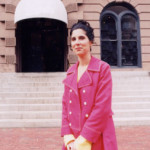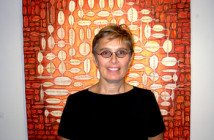“You’ve known me since I was a little squirt,” Kathy Bitetti laughed as we met for a beer and burger to discuss her remarkable multi tasking as artist, curator, public policy advocate and long term director of The Artists Foundation, which was incorporated in 1973. Truthfully, Kathy nursed two rounds of cranberry juice matched by my Sam seasonals. We met ages ago when she was the director of the Harbor Gallery (1989-1992) at University of Massachusetts, Boston while I spent a semester as a visiting professor. It was fun to drop in the gallery between classes to see what she was up to.
Later, we connected when she took over as director of the Artists Foundation in June of 1992. The Foundation was originally formed as a vehicle to distribute grants to artists through the Mass Council for the Arts and Humanities. It was then located in generous space in the Transportation Building in Park Square of downtown Boston. The new building was a part of an attempt to reclaim the area which was notorious as a red-light district. Last night, Astrid and I went to the movies and dined in Chinatown which abuts that area. We were astonished by all the new construction and, just for nostalgia, walked up LaGrange Street which houses the strip joints, Glass Slipper, and Centerfolds; all that is left of the once thriving porn business. Back in the day, my Irish grandfather operated saloons in the area but they were for men only. The site of his legendary Silver Dollar Bar now houses the Registry of Motor Vehicles. I pointed out the beautifully renovated office building on the corner of LaGrange and Washington Streets, the only surviving commercial building from the firm of H.H. Richardson. Astrid informed me that I mention it virtually every time we walk through Chinatown
By 1994, the lease was up for free rent and the Artists Foundation relocated to significantly smaller quarters at 516 East Second Street in South Boston. In three small spaces they present 21 one person shows each year. One of those tiny galleries represents the only ongoing venue in the state dedicated to one person video shows. So, while scaled back to the bare bone, the Artists Foundation continues to do important work and has sustained relationships with artists in all aspects of their issues and careers. Much of what they do involves advocacy and public policy. Artists are urged to sign up for their bulletins that range from housing and jobs, to grants, and policy information. You can reach them from Maverick links under Boston galleries and museums.
Since 1999, she has been the curator of the Lillian Immig Gallery of Emmanuel College. She organizes several group shows each year which support the teaching program. Although it is a Catholic college she has enjoyed complete freedom and is known for presenting edgy and thought provoking shows. She also spends part of her week working for a private family foundation which is not arts related. Like a lot of artist/ curators of her generation she does a bit of juggling to make a living while creating her own work and projects. The actual commitment of hours is daunting. But part of making it work, she explained to me, is drawing a clear line between professional and private life.
She tries to attend the openings of artists she works with but isn’t interested in making the scene. “I could care less about the MFA,” she said. “They have no interest in artists so I have no real interest in them.” What about the ICA, I asked? “No, I don’t much care about their shows either.” Does she prefer a rich family life? “Hey, we’re Italians,” she says with a laugh. “But remember I’m only half Italian. My mother is Polish.” I met her mother years ago and we swapped recipes for lasagna. Kathy says she still asks about me. But for Kathy, again laughing, it’s all about “family.” The artists she hangs with are a part of her family. Including me I guess. It is a different and quite wonderful way of looking at the art world which often seems strident, careerist and capitalist. Kathy is an enabler who cares deeply about the work, her own, and that of others. There is a generosity of spirit.
Right now, she is completing a two year, artist in residence relationship with the city of Quincy where she was born in 1968. It is the “City of Presidents,” the Adams family, and she is bringing it all back home. She is working with the Quincy Historical Society, The Thomas Crane Public Library (another H.H. Richardson building by the way), Quincy High School, DOVE a domestic violence prevention organization, and the Adams National Historic Park.
“I have been doing a project related to Quincy and about me being from Quincy,” she explained. So far, that has involved two exhibitions at the library which was connected to her participation in an exhibition at the De Cordova Museum “Pretty Sweet: Sentiment in Art” (January through April, 2005). She did a number of off site pieces that presented work based on domestic violence. In the spring of 2006 she will do a similar project in Newburyport, Mass. Much of her involvement with domestic violence dates back to high school and the experiences of a best friend.
Initially, she was not involved with art and spent a troubled semester at Brandeis University as a premed student. There she took an eye opening art history class and transferred to U. Mass where she had a double major in art as well as economics and public policy. The art major was split between studio courses and art history. Eventually, she aspires to pursue a Ph.D. in public policy and a career as an arts advocate. Even now she spends a lot of time roaming the back halls of the State House where she works closely with Legislators.
As part of the Quincy project she made three dresses while in residence at the Abigail Adams house. She precisely measured an heirloom dress worn by Abigail, one of the truly remarkable women of her generation. Another dress is based on the dimensions of Princess Sophia, the artist’s alter ego. “You’ve met her,” Kathy said. “She likes you.” And a third dress based on Barbie scaled up from the doll to life sized dimensions. The three dresses will be displayed as part of an exhibition “Plastic Princess: Barbie as Art” curated by Leonie Bradbury which will be on view at the Montserrat College of Art in Beverly, Mass. from November 10 through February 11. The group show will include some of Kathy’s gal pals; Cynthia von Buhler, now living in New York and the subject of an earlier show at Montserrat, as well as, Pia Schachter, and a guy, Joe Gibbons.
Why Barbie I asked? That resulted in a bit of history. It seems the doll was introduced in 1959 and was created by Ruth Handler and her husband Elliot. It was based on a German fetish doll “Lilli” which was fashioned after a famous cartoon character, a hooker with a heart of gold, and a fantasy for men. Barbie was named for the Handler’s daughter and her male companion, Ken, after their son. Initially, parents shunned the doll with such voluptuous proportions. At her original scale Barbie’s bust was about a 32 Triple D with legs that don’t quit. But her creators viewed her as “liberated” and a fashion model not a Mom. She was marketed to children through ads on TV and within ten years Mattel sold $500 million in Barbie products.
So has Barbie inspired little girls to grow up as tarts? “It worked,” Kathy exclaimed. “Just look at how kids dress. When I grew up in Quincy you couldn’t escape Barbie. She was one bookend. The other was Abigail Adams. You learned all about her in school and visited her home. So that’s what my piece, Sewing for Abigail, is all about and the Princess is in the middle. By the way, Barbie has broken up with Ken. Now she’s dating Blaine who is a surfer dude from Australia.”
We talked a bit about the collateral damage of girls growing up with Barbie, Ken, and Blaine as role models. What impact that has on the psyche of girls who just want to have fun. Kathy talked about the dimensions of top fashion models who averaged about 5’ 7” twenty years ago and now are 6’ and more with a weight of between 110 and 115 pounds. Can there be any wonder why teenage girls, one in four, suffer eating disorders? Even the would be Kens and Blaines have similar issues.
You can learn more about her projects at www.princesssophia.com. While amusing, there is also a dark side and edge to the work. Make a point to check out that Montserrat show. And sign up for the free listings of the Artists Foundation. She is also a columnist for Arts Media and is about to start writing for Big Red and Shiny. “I just want to get information out there that’s useful to artists,” she states. “I’m not interested in being a critic.” It’s nice to meet a Princess who isn’t a royal pain.
Links:
Artists Foundation
Princess Sophia
The Princess Project
"Plastic Princess: Barbie as Art" is on view November 11, 2005 - February 4, 2006 at Monserrat College of Art.





